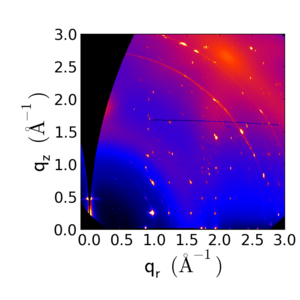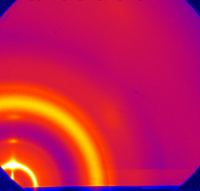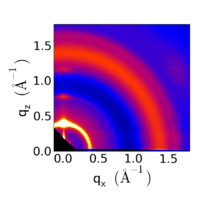Difference between revisions of "GIWAXS"
KevinYager (talk | contribs) (→Example Data) |
KevinYager (talk | contribs) (→Rubrene:) |
||
| Line 17: | Line 17: | ||
[[Image:TungstenNickel.png|300px]] | [[Image:TungstenNickel.png|300px]] | ||
| − | ===Rubrene | + | ===Rubrene=== |
Notice the well-defined peaks through the WAXS. These diffraction peaks appear as spots (as opposed to rings) because the material is well-oriented with respect to the substrate. Instead of ordering in an isotropic manner, this sample has a very well-defined crystallographic orientation with respect to the substrate (because of epitaxial substrate growth). | Notice the well-defined peaks through the WAXS. These diffraction peaks appear as spots (as opposed to rings) because the material is well-oriented with respect to the substrate. Instead of ordering in an isotropic manner, this sample has a very well-defined crystallographic orientation with respect to the substrate (because of epitaxial substrate growth). | ||
[[Image:Rubrene GIWAXS example.png|300px]] | [[Image:Rubrene GIWAXS example.png|300px]] | ||
Revision as of 16:32, 14 October 2014
Grazing-Incidence Wide-Angle X-ray Scattering (GIWAXS) is a structural measurement technique wherein wide-angle scattering is collected; i.e. large values of the momentum transfer. Because of the inverse nature of reciprocal-space, these large values of q correspond to small distances; WAXS generically probes molecular length-scales.
There is no unambiguous delineation between WAXS and SAXS; generally speaking, WAXS corresponds to angles from approximately 1° to 45°, or q-values from 0.1 Å−1 to 5 Å−1 (realspace distances from 6 nm to Angstroms).
Example Data
P3HT
Different representations of data from a P3HT thin film. The fairly broad rings are consistent with the small grain sizes (~20 nm) in this material. The P3HT lamellar-stacking peaks (100, 200, 300) are concentrated along the vertical, due to the preferentially 'edge-on' orientation of this material, with respect to the substrate.
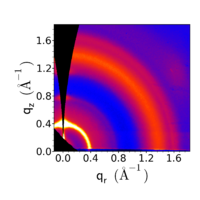 Data converted to q-space, taking into account the Ewald sphere (notice the 'missing wedge' near the qz axis). |
Tungsten-Nickel alloy
The many bright rings arise from the well-defined atomic [[unit cell]. The peaks appear at large q (a.k.a. large angle), because they arise from small (atomic) distance-scales. The peaks are sharp, indicative of large grains; in fact they appear somewhat speckled, indicative of a well-ordered material.
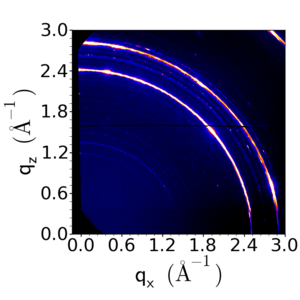
Rubrene
Notice the well-defined peaks through the WAXS. These diffraction peaks appear as spots (as opposed to rings) because the material is well-oriented with respect to the substrate. Instead of ordering in an isotropic manner, this sample has a very well-defined crystallographic orientation with respect to the substrate (because of epitaxial substrate growth).
